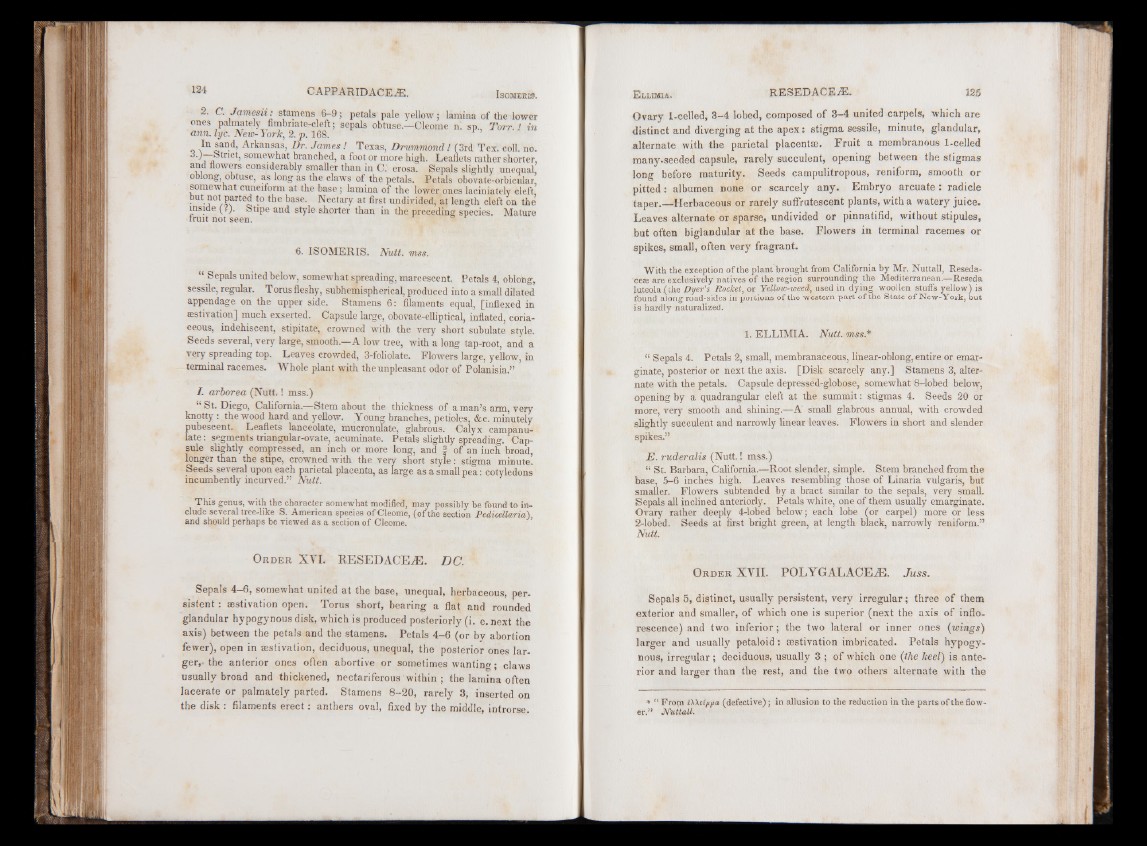
2. C. Jamesii: stamens 6-9; petals pale yellow; lamina of the lower
ones palmately fimbriate-cleft; sepals obtuse.—Cleome n. sp„ Torr. ' in
ann. lye. New- York, 2. p. 168.
In sand, Arkansas, Dr. James ! Texas, Drummond ! (3rd Tex. coll. no.
d-J—Strict, somewhat branched, a foot or more high. Leaflets rather shorter,
and flowers considerably smaller than in C. erosa. Sepals slightly unequal,
oblong, obtuse, as long as the claws of the petals. Petals obovate-orbicular,
somewhat cuneiform at the base; lamina of the lower ones laciniately cleft,
but not parted to the base. Nectary at first undivided, at length cleft on the
inside (s). Stipe and style shorter than in the preceding species. Mature
fruit not seen. p
6. ISOMERIS. Nutt. mss.
“ Sepals united below, somewhat spreading, marcescent. Petals 4, oblong,
sessile, regular. T orus fleshy, subhemispherical, produced into a small dilated
appendage on the upper side. Stamens 6 : filaments equal, [infiexed in
aestivation] much exserted. Capsule large, obovate-elliptical, inflated, coriaceous,
indehiscent, stipitate, crowned with the very short subulate style.
Seeds several, very large, smooth—A low tree, with a long tap-root, and a
very spreading top. Leaves crowded, 3-foliolate. Flowers large, yellow, in
terminal racemes. Whole plant with the unpleasant odor of Polanisia.”
I. arborea (Nutt.! mss.)
St. Diego, California. Stem about the thickness of a manJs arm, very
knotty: the wood hard and yellow. Young branches, petioles, &c. minutely
pubescent. Leaflets lanceolate, mucronulate, glabrous. Calyx campanu-
late: segments triangular-ovate, acuminate. Petals slightly spreading. Capsule
slightly compressed, an inch or more long, and § of an inch broad,
longer than the stipe, crowned with the very short style: stigma minute.
Seeds several upon each parietal placenta, as large as a small pea: cotyledons
incumbently incurved.” Nutt.
This genus, with the character somewhat modified, may possibly be found to include
several tree-like S. American species of Cleome, (of the section Pedicellaria),
and should perhaps be viewed as a section of Cleome.
Or d e r XYI. RESEDACEÆ. DC.
Sepals 4-6, somewhat united at the base, unequal, herbaceous, per-
sistent : aestivation open. Torus short, bearing a flat and rounded
glandular hypogynous disk, which is produced posteriorly (i. e. next the
axis) between the petals and the stamens. Petals 4-6 (or by abortion
fewer), open in aestivation, deciduous, unequal, the posterior ones larger,
the anterior ones often abortive or sometimes wanting ; claws
usually broad and thickened, nectariferous within ; the lamina often
lacerate or palmately parted. Stamens 8-20, rarely 3, inserted on
the disk : filaments erect : anthers oval, fixed by the middle, introrse.
Ovary 1-celled, 3-4 lobed, composed of 3-4 united carpels, which are
distinct and diverging at the apex: stigma sessile, minute, glandular,
alternate with the parietal placentae. Fruit a membranous 1-celled
many-seeded capsule, rarely succulent, opening between the stigmas
long before maturity. Seeds campulitropous, reniform, smooth or
p itted : albumen none or scarcely any. Embryo arcuate : radicle
taper.—Herbaceous or rarely sufirutescent plants, with a watery juice.
Leaves alternate or sparse, undivided or pinnatifid, without stipules,
but often biglandular at the base. Flowers in terminal racemes or
spikes, small, often very fragrant.
With the exception of the plant brought from California by Mr. Nuttall, Reseda-
ce* are exclusively natives of the region surrounding the Mediterranean.—Reseda
luteola (the Dyer's Rocket, or Yellow-weed, used in dying woollen stuffs yellow) is
found along road-sides in portions of the western part of the State of New-York, but
is hardly naturalized.
1. ELLIMIA. Nutt, mss.*
“ Sepals 4. Petals 2, small, membranaceous, linear-oblong, entire or emar-
ginate, posterior or next the axis. [Disk scarcely any.] Stamens 3, alternate
with the petals. Capsule depressed-globose, somewhat 8-lobed below,
opening by a quadrangular cleft at the summit: stigmas 4. Seeds 20 or
more, very smooth and shining.—A small glabrous annual, with crowded
slightly succulent and narrowly linear leaves. Flowers in short and slender
spikes.”
E . ruderalis (Nutt.! mss.)
“ St. Barbara, California.—Root slender, simple. Stem branched from the
base, 5-6 inches high. Leaves resembling those of Linaria vulgaris, but
smaller. Flowers subtended by a bract similar to the sepals, very small.
Sepals all inclined anteriorly. Petals white, one of them usually emarginate.
Ovary rather deeply 4-lobed below; each lobe (or carpel) more or less
2-lobed. Seeds at first bright green, at length black, narrowly reniform.”
Nutt.
Or d e r XYII. POLYGALACEÆ. Juss.
Sepals 5, distinct, usually persistent, very irregular ; three of them
exterior and smaller, of which one is superior (next the axis of inflorescence)
and two inferior ; the two lateral or inner ones (wings)
larger and usually petaloid : aestivation imbricated. Petals hypogynous,
irregular ; deciduous, usually 3 ; of which one (the keel) is anterior
and larger than the rest, and the two others alternate with the
* “ From IWcifL/ia (defective); in allusion to the reduction in the parts of the low-
er.” Nuttall.